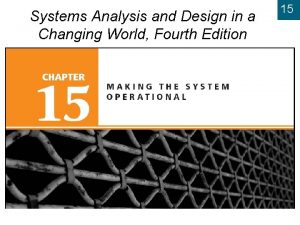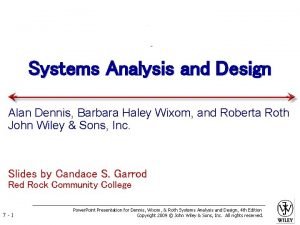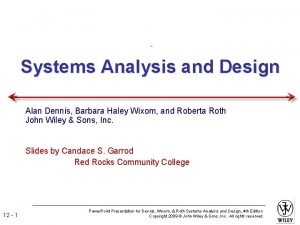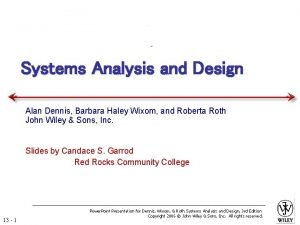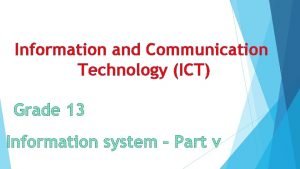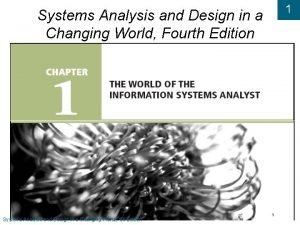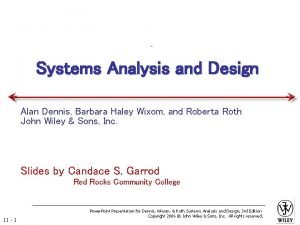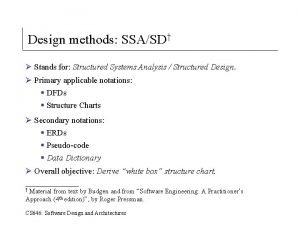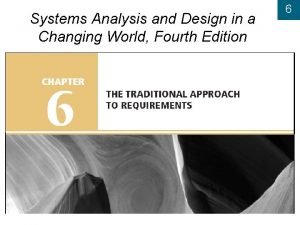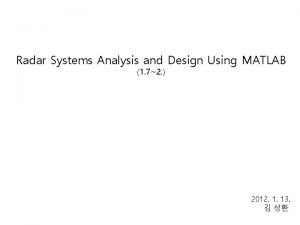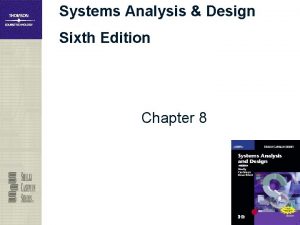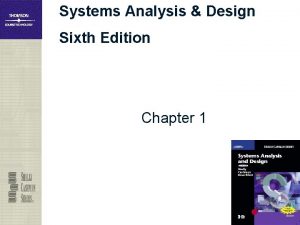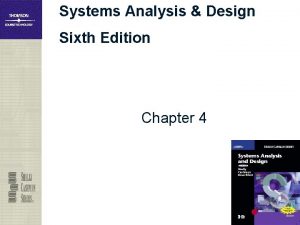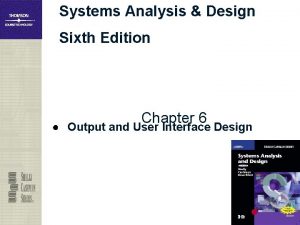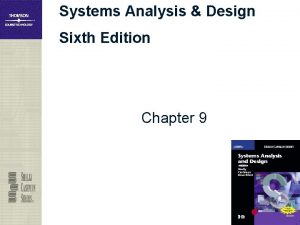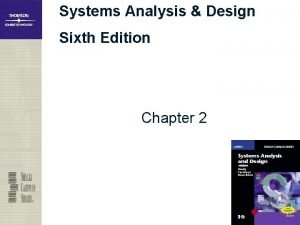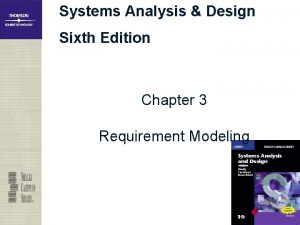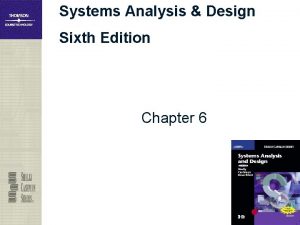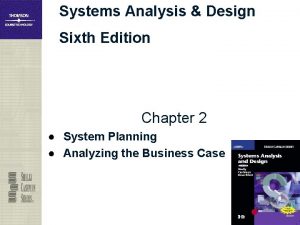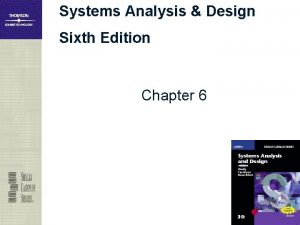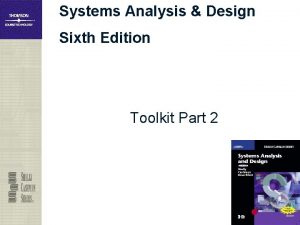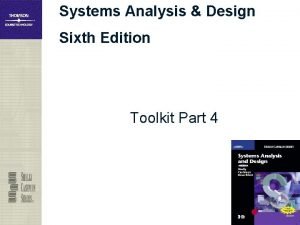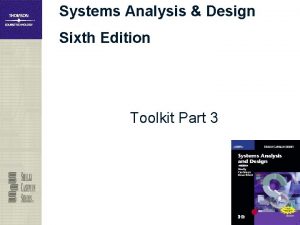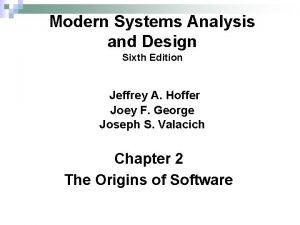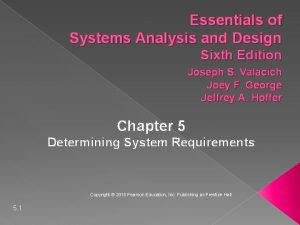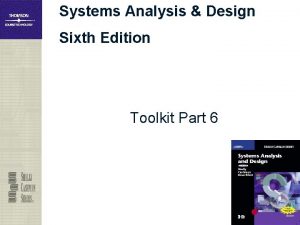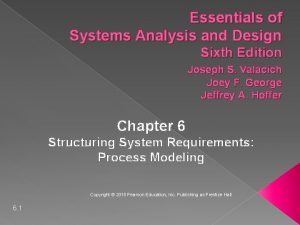Systems Analysis Design Sixth Edition Chapter 7 Chapter





















































- Slides: 53

Systems Analysis & Design Sixth Edition Chapter 7

Chapter Objectives ● Explain data design concepts and data structures ● Describe file processing systems and various types of files ● Understand database systems and define the components of a database management system (DBMS) ● Describe Web-based data design 2

Chapter Objectives ● Explain data design terminology, including entities, fields, common fields, records, files, tables, and key fields ● Describe data relationships, draw an entity-relationship diagram, define cardinality, and use cardinality notation ● Explain the concept of normalization ● Explain the importance of codes and describe various coding schemes 3

Chapter Objectives ● Describe relational and object-oriented database models ● Explain data warehousing and data mining ● Differentiate between logical and physical storage and records ● Explain data control measures 4

Introduction ● You will develop a physical plan for data organization, storage, and retrieval ● Begins with a review of data design concepts and terminology, then discusses file-based systems and database systems, including Webbased databases ● Concludes with a discussion of data storage and access, including strategic tools such as data warehousing and data mining, physical design issues, logical and physical records, data storage formats, and data control 5

Data Design Concepts ● Data Structures – A file or table contains data about people, places, things, or events that interact with the system – File-oriented system – File processing system – Database system 6

Data Design Concepts ● Overview of File Processing – Potential problems • Data redundancy • Data integrity • Rigid data structure 7

Data Design Concepts ● Overview of File Processing – Uses various types of files • • • Master file Table file Transaction file Work file – scratch file Security file History file 8

Data Design Concepts ● Overview of Database Systems – A properly design database system offers a solution to the problems of file processing – Provides an overall framework that avoids data redundancy and supports a real-time, dynamic environment – Database management system (DBMS) – The main advantage of a DBMS is that it offers timely, interactive, and flexible data access 9

Data Design Concepts ● Overview of Database Systems – Advantages • • • Scalability Better support for client/server systems Economy of scale Flexible data sharing Enterprise-wide application – database administrator (DBA) • Stronger standards 10

Data Design Concepts ● Overview of Database Systems – Advantages • • Controlled redundancy Better security Increased programmer productivity Data independence 11

Data Design Concepts ● Database Tradeoffs – Because DBMSs are powerful, they require more expensive hardware, software, and data networks capable of supporting a multi-user environment – More complex than a file processing system – Procedures for security, backup, and recovery are more complicated and critical 12

DBMS Components ● Interfaces for Users, Database Administrators, and Related Systems – Users • Query language • Query by example (QBE) • SQL (structured query language) – Database Administrators • A DBA is responsible for DBMS management and support 13

DBMS Components ● Interfaces for Users, Database Administrators, and Related Systems – Related information systems • A DBMS can support several related information systems that provide input to, and require specific data from, the DBMS 14

DBMS Components ● Data Manipulation Language – A data manipulation language (DML) controls database operations, including storing, retrieving, updating, and deleting data ● Schema – The complete definition of a database, including descriptions of all fields, tables, and relationships, is called a schema – You also can define or more subschemas 15

DBMS Components ● Physical Data Repository – The data dictionary is transformed into a physical data repository, which also contains the schema and subschemas – The physical repository might be centralized, or distributed at several locations – ODBC – open database connectivity – JDBC – Java database connectivity 16

Web-Based Database Design ● Characteristics of Web-Based Design – In a Web-based design, the Internet serves as the front end, or interface, for the database management system – Internet technology provides enormous power and flexibility – Web-based systems are popular because they offer ease of access, cost-effectiveness, and worldwide connectivity 17

Web-Based Database Design ● Internet Terminology – – – – Web browser Web page HTML – Hypertext Markup Language Tags Web server Web site Intranet 18

Web-Based Database Design ● Internet Terminology – – – Extranet Protocols Web-centric Clients Servers 19

Web-Based Database Design ● Connecting a Database to the Web – Database must be connected to the Internet or intranet • Middleware • Macromedia’s Cold. Fusion 20

Web-Based Database Design ● Data Security – Web-based data must be totally secure, yet easily accessible to authorized users – To achieve this goal, well-designed systems provide security at three levels: the database itself, the Web server, and the telecommunication links that connect the components of the system 21

Data Design Terminology ● Definitions – Entity – Table or file – Field • Attribute • Common field – Record • Tuple 22

Data Design Terminology ● Key Fields – Primary key • • Combination key Composite key Concatenated key Multi-valued key – Candidate key • Nonkey field – Foreign key – Secondary key 23

Data Design Terminology ● Referential Integrity – Validity checks can help avoid data input errors 24

Entity-Relationship Diagrams ● An entity is a person, place, thing, or event for which data is collected and maintained ● Provides an overall view of the system, and a blueprint for creating the physical data structures ● Entity-relationship diagram 25

Entity-Relationship Diagrams ● Drawing an ERD – The first step is to list the entities that you identified during the fact-finding process and to consider the nature of the relationships that link them 26

Entity-Relationship Diagrams ● Types of Relationships – One-to-one relationship (1: 1) – One-to-many relationship (1: M) – Many-to-many relationship (M: N) • Associative entity ● Cardinality • Cardinality notation • Crow’s foot notation • Unified Modeling Language (UML) 27

Normalization ● Table design ● Involves four stages: unnormalized design, first normal form, second normal form, and third normal form ● Most business-related databases must be designed in third normal form 28

Normalization ● Standard Notation Format – Designing tables is easier if you use a standard notation format to show a table’s structure, fields, and primary key Example: NAME (FIELD 1, FIELD 2, FIELD 3) 29

Normalization ● Repeating Groups and Unnormalized Designs – Repeating group • Often occur in manual documents prepared by users – Unnormalized design 30

Normalization ● First Normal Form – A table is in first normal form (1 NF) if it does not contain a repeating group – To convert, you must expand the table’s primary key to include the primary key of the repeating group ● Second Normal Form – To understand second normal form (2 NF), you must understand the concept of functional dependence – Functionally dependent 31

Normalization ● Second Normal Form – A standard process exists for converting a table from 1 NF to 2 NF 1. Create and name a separate table for each field in the existing primary key 2. Create a new table for each possible combination of the original primary key fields 3. Study the three tables and place each field with its appropriate primary key 32

Normalization ● Second Normal Form – Four kinds of problems are found with 1 NF designs that do not exist in 2 NF • Consider the work necessary to change a particular product’s description • 1 NF tables can contain inconsistent data • Adding a new product is a problem • Deleting a product is a problem 33

Normalization ● Third Normal Form – 3 NF design avoids redundancy and data integrity problems that still can exist in 2 NF designs – A table design is in third normal form (3 NF) if it is in 2 NF and if no nonkey field is dependent on another nonkey field – To convert the table to 3 NF, you must remove all fields from the 2 NF table that depend on another nonkey field and place them in a new table that uses the nonkey field as a primary key 34

Normalization ● A Normalization Example – To show the normalization process, consider the familiar situation, which depicts several entities in a school advising system: ADVISOR, COURSE, and STUDENT 35

Using Codes During Data Design ● Overview of Codes – Because codes often are used to represent data, you encounter them constantly in your everyday life – They save storage space and costs, reduce transmission time, and decrease data entry time – Can reduce data input errors 36

Using Codes During Data Design ● Types of Codes 1. Sequence codes 2. Block sequence codes 3. Alphabetic codes a. Category codes b. Abbreviation codes – mnemonic codes 4. 5. 6. 7. Significant digit codes Derivation codes Cipher codes Action codes 37

Using Codes During Data Design ● Developing a Code 1. 2. 3. 4. 5. 6. 7. 8. 9. Keep codes concise Allow for expansion Keep codes stable Make codes unique Use sortable codes Avoid confusing codes Make codes meaningful Use a code for a single purpose Keep codes consistent 38

Steps in Database Design 1. Create the initial ERD 2. Assign all data elements to entities 3. Create 3 NF designs for all tables, taking care to identify all primary, secondary, and foreign keys 4. Verify all data dictionary entries 5. After creating your final ERD and normalized table designs, you can transform them into a database 39

Database Models ● Relational Databases – The relational model was introduced during the 1970 s and became popular because it was flexible and powerful – Because all the tables are linked, a user can request data that meets specific conditions – New entities and attributes can be added at any time without restructuring the entire database 40

Database Models ● Object-Oriented Databases – Many systems developers are using objectoriented database (OODB) design as a natural extension of the object-oriented analysis process • Object Data standard • Object Database Management Group (ODMG) • Each object has a unique object identifier 41

Data Storage and Access ● Data storage and access involve strategic business tools ● Strategic tools for data storage and access – Data warehouse - dimensions 42

Data Storage and Access ● Strategic tools for data storage and access – Data Mining • • • Increase average pages viewed per session Increase number of referred customers Reduce clicks to close Increase checkouts per visit Increase average profit per checkout 43

Data Storage and Access ● Logical and Physical Storage – Logical storage • Characters • Data element or data item • Logical record – Physical storage • Physical record or block • Buffer • Blocking factor 44

Data Storage and Access ● Data Storage Formats – – – Binary digits Bit Byte EBCDIC and ASCII Unicode 45

Data Storage and Access ● Data Storage Formats – Binary • • Binary storage format Integer format Long integer format Other binary formats exist for efficient storage of exceedingly long numbers 46

Data Storage and Access ● Selecting a Data Storage Format – In many cases, a user can select a specific data storage format – For example, when using Microsoft Office, you can store documents, spreadsheets, and databases in Unicode-compatible form by using the font called Arial Unicode MS – Best answer is it depends on the situation 47

Data Storage and Access ● Date Fields – Most date formats now are based on the model established by the International Organization for Standardization (ISO) – Can be sorted easily and used in comparisons – Absolute date – Best method depends on how the specific date will be printed, displayed, or used in a calculation 48

Data Control ● File and database control must include all measures necessary to ensure that data storage is correct, complete, and secure ● A well-designed DBMS must provide built-in control and security features, including subschemas, passwords, encryption, audit trail files, and backup and recovery procedures to maintain data 49

Data Control ● ● ● ● User ID Password Permissions Encryption Backup Recovery procedures Audit log files Audit fields 50

Chapter Summary ● Files and tables contain data about people, places, things, or events that affect the information system ● DBMS designs are more powerful and flexible than traditional file-oriented systems 51

Chapter Summary ● Data design tasks include creating an initial ERD; assigning data elements to an entity; normalizing all table designs; and completing the data dictionary entries for files, records, and data elements ● Logical storage is information seen through a user’s eyes, regardless of how or where that information actually is organized or stored 52

Chapter Summary ● Physical storage is hardware-related and involves reading and writing blocks of binary data to physical media ● File and database control measures include limiting access to the data, data encryption, backup/recovery procedures, audit-trail files, and internal audit fields ● Chapter 7 complete 53
 Peter pickle tongue twister
Peter pickle tongue twister The sixth sick sheik's sixth sheep's sick lyrics
The sixth sick sheik's sixth sheep's sick lyrics Modern system analysis and design
Modern system analysis and design Modern systems analysis and design 7th edition
Modern systems analysis and design 7th edition Biochemistry sixth edition 2007 w.h. freeman and company
Biochemistry sixth edition 2007 w.h. freeman and company Computer architecture a quantitative approach sixth edition
Computer architecture a quantitative approach sixth edition Automotive technology sixth edition
Automotive technology sixth edition Automotive technology sixth edition
Automotive technology sixth edition Citation sample pdf
Citation sample pdf Computer architecture a quantitative approach 6th
Computer architecture a quantitative approach 6th Precalculus sixth edition
Precalculus sixth edition Rational people think at the margin
Rational people think at the margin Computer architecture a quantitative approach sixth edition
Computer architecture a quantitative approach sixth edition Domain model specification in iot system design methodology
Domain model specification in iot system design methodology Hamlet's soliloquy
Hamlet's soliloquy Using mis (10th edition) 10th edition
Using mis (10th edition) 10th edition Mis
Mis The sixth extinction chapter 3 summary
The sixth extinction chapter 3 summary Systems analysis and design in an age of options
Systems analysis and design in an age of options Gantt chart system analysis and design
Gantt chart system analysis and design Systems analysis and design in a changing world
Systems analysis and design in a changing world System analysis and design in a changing world
System analysis and design in a changing world Alan dennis system analysis design
Alan dennis system analysis design System analysis and design
System analysis and design Ssadm
Ssadm Modern systems analysis and design
Modern systems analysis and design Kendall & kendall systems analysis and design
Kendall & kendall systems analysis and design Systems analysis and design alan dennis
Systems analysis and design alan dennis Systems analysis and design alan dennis
Systems analysis and design alan dennis Systems analysis and design alan dennis
Systems analysis and design alan dennis Systems analysis and design alan dennis
Systems analysis and design alan dennis Systems analysis and design alan dennis
Systems analysis and design alan dennis Systems analysis and design alan dennis
Systems analysis and design alan dennis Systems analysis and design alan dennis
Systems analysis and design alan dennis Structured systems analysis and design method
Structured systems analysis and design method Radar range equation snr
Radar range equation snr Object-oriented systems analysis and design using uml
Object-oriented systems analysis and design using uml A modern approach to systems analysis and design
A modern approach to systems analysis and design Patched up prototype
Patched up prototype Kendall kendall
Kendall kendall System analysis and design in a changing world
System analysis and design in a changing world Systems analysis and design in a changing world
Systems analysis and design in a changing world Systems analysis and design in a changing world
Systems analysis and design in a changing world Systems analysis and design alan dennis
Systems analysis and design alan dennis Systems analysis and design alan dennis
Systems analysis and design alan dennis Systems analysis and design alan dennis
Systems analysis and design alan dennis Ssadm
Ssadm Essentials of systems analysis and design
Essentials of systems analysis and design Systems analysis and design in a changing world
Systems analysis and design in a changing world Systems analysis and design alan dennis
Systems analysis and design alan dennis Structured systems analysis and design method
Structured systems analysis and design method System analysis and design in a changing world
System analysis and design in a changing world Systems analysis and design in a changing world
Systems analysis and design in a changing world Radar system analysis and design using matlab
Radar system analysis and design using matlab








































